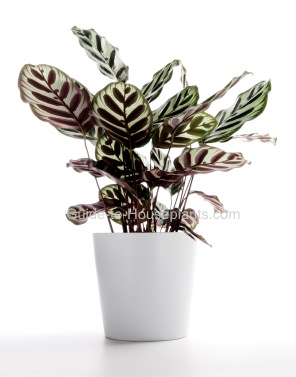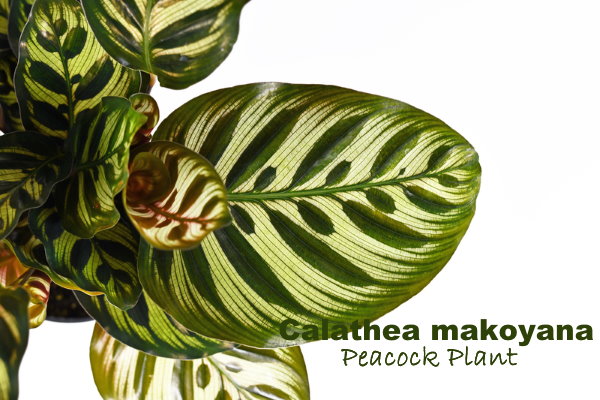How to Grow Peacock Plant
Botanical Name: Calathea makoyana
Peacock Plant is a member of the Marantaceae family of prayer plants. This is one of the showiest in the clan; treat it right and you'll watch it strut its stuff.

Tall, slender stems hold up the oval leaves that can grow to 12 in (30 cm) long. New leaves are rolled up when they emerge and are pinkish-red on the undersides.
The bold, decorative markings of its thin, delicate leaves resemble a peacock's tail, lending this beautiful Calathea plant its common name. They are pale green with feathered dark-green lines from the midrib to the outside edges of the leaf. Asymetrical stripes add an exquisite effect.
You'll see them fold up at night. Just like other members of the prayer plant family, Peacock Plant folds its leaves when it's dark.
Calathea Makoyana Problems, Solutions and Answers
Brown leaf tips indicate low humidity, fluoride in water, or too much fertilizer.
Raise the humidity. Calatheas are fussy about humidity and love to be misted. If the leaves turn yellow or brown, it is likely because the air is too dry. Use every practical way to keep the relative humidity above 60%, especially in winter. I recommend using a humidity tray or room humidifier.
Leaves that curl up probably aren't getting enough water. Aim to keep the potting medium lightly moist, but not soggy which can cause root rot. I use a moisture meter for houseplants rather than guess how much water is deep in the pot. It's the only sure-fire way to know if I'm watering enough -- or too much.
Repot in spring. Move up to a pot 1 size larger when the plant outgrows its pot. This is a good time to divide large, crowded plants. Use a container with drainage holes to avoid overwatering which can lead to root rot.
Is Calathea makoyana poisonous? No, this tropical native is non-toxic to people, cats and dogs.
Something bugging your plant? Peat-based potting mixes that are kept moist may attract fungus gnats. Fortunately, they don't do a lot of harm to houseplants, but they do multiply quickly and may move on to your other indoor plants. Spider mites love dry indoor air and may invade when the humidity drops in winter. Like true spiders they will leave webs between stems and leaves. They suck plant juices, leaving behind pale, speckled foliage and stems. Treat any infestation immediately.
 Stunning foliage makes Peacock Plant worth pampering a bit. Photo: © Monikabaumbach
Stunning foliage makes Peacock Plant worth pampering a bit. Photo: © MonikabaumbachPeacock Plant Care
Origin: Brazil
Height: Up to 2 ft (60 cm)
Light: Low to moderate light. Keep this showy Calathea plant out of direct sun to avoid dulling the colors of the leaves.
Water: Keep mix evenly moist at all times, but not soggy. Use distilled or rain water because Peacock Plant is sensitive to fluoride and other chemicals in many public water supplies.
Humidity: Requires moist air (aim to maintain 60% relative humidity around the plant). Set pot on a tray of wet pebbles and mist leaves frequently with room-temperature water. If indoor air is extremely dry during the winter months, it's a good idea to use a cool-mist room humidifier.
Temperature: Average to warm room temperatures 70-85°F/21-29°C
Soil: Peat moss based potting mix
Fertilizer: Feed monthly with a balanced house plant fertilizer diluted by half spring through fall. Do not feed in winter. New leaves that are lighter in color aren't getting enough nitrogen or iron. If your fertilizer doesn't contain these nutrients, use a foliar spray that lists these nutrients on the bottle. You should see an improvement within a few weeks.
Propagation: Division. Calathea plant is not easy to divide, so divide the plant in spring only when it gets quite large.


